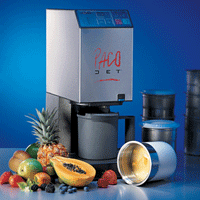Chefs are getting really creative, thanks to new and old-style mixers and blenders
Top chefs say mixers, blenders and dicers run the gamut from the mundane to the truly innovative. As John Higgins, director & Corporate Chef at George Brown College’s Chef’s School in Toronto, puts it, “There’s the regular stuff; then there are the toys.”
The “regular stuff” is your usual countertop blenders, immersion blenders, food processors, dough mixers and other workhorse items considereed staples in every kitchen. But even these tried and true basics have been improving with age, with the addition of new health and safety features, more durable finishes and sturdy elements that will keep them running for decades.
Then there’s the “crème de la crème” equipment every chef loves to talk about and get their hands on, such as Pacojets, Thermomixes and Robot Coupes. If you’re John Placko, director of Culinary Excellence for Maple Leaf Foods in Mississauga, you might even create a Facebook fan page just to share that enthusiasm. (To date, Placko has a Pacojet and Thermomix appreciation society page on the go.)
Blending for perfection // Higgins also joins many chefs in singing the praises of the Pacojet, a coffee-machine-style device very popular in Europe, which precisely measures frozen ingredients (from one 100-mililtre serving to 10) from a canister and grinds them to an ultra-fine purée. “The colour and flavour are perfect,” he says. “You can use it for pestos, sauces, soups and mousses. You can make ice cream so fine it’s unbelievable. At $3,500 it’s an expensive toy. But it’s worth it.”
Placko agrees. “Since the blade shaves at a rate of 2,000 revolutions per minute, particles can be taken down to two microns to make extremely velvety ice cream,” he explains. “And since you can specify one to 10 portions, you can customize layers of ice cream or paté, for example.”
At Oliver & Bonacini Restaurants in Toronto, corporate executive chef Anthony Walsh says he uses his collection of Pacojets for a lot of high-volume applications, such as parsley sauces. “Because the product is compressed and not a watered-down purée, the flavour intensity is significantly higher,” he explains.
While Robot Coupes may have been on the market longer than Pacojets, they’re also appreciated for their durability, speed, efficiency and size. “Because Robot Coupes only take up an 8 x 10-inch area, they’re very portable,” Placko notes. “And the high-speed blades allow for all kinds of preparations, from emulsions and mousses to dressings and sauces. They’re very, very versatile.”
Robot Coupe definitely passes the durability test, says Higgins. “It’s all stainless steel, so I could drop it on the floor and nothing would happen to it.” He also prefers stainless steel, since plastic can accumulate bad odours over time.
Higgins’ kitchen is also home to two Vorwerk Thermomix units ($1,000 each), which he likens to a coffee machine that dices, slices, weighs and cooks ingredients in a small chamber. “It’s perfect for sauces. “I can set it up to measure sugar, eggs and milk, set the temperature, and it will cook a sauce perfectly every time. It’s absolutely dynamite. If you’re a small restaurant owner, you could make perfect béarnaise sauce 100 times with a tool that hardly takes up any room at all.”
Because a Thermomix weighs, cooks, blends and has a timer all built into one, Placko says it’s ideal for performing techniques that normally require a lot of skill. “Like with sous vide — you get a perfect result every time. It allows you to prepare food in advance of busy service times, and reduces the need for highly skilled staff.”
David Gunawan, chef de cuisine for West in Vancouver, says he has been using a Thermomix to make hollandaise, pot au crème and crème brûlée, because it can cook and whisk at the same time. “You don’t have to stand over a bain-marie. All you do is turn it to the desired temperature and it does everything for you. It’s very cool that way.”
“The big, big deal with the Thermomix is the consistency of the product going onto the plate,” O&B’s Walsh adds.
Smooth operations // While these tools may be more prevalent in fine dining and the cooking schools of the world, mainstream food-processing technologies are also getting their fair share of attention. For example, Paul Le Clerc, sales manager for Serve-Canada Food Equipment in Toronto, reports that sales for immersion and countertop blenders are growing by leaps and bounds for one simple reason: smoothies and iced coffees. “As people are getting into menu enhancements, blenders have become a huge category,” he says.
Depending on the volumes and applications, the cost of a blender can run anywhere from $100 to $1,000, with jar sizes ranging from 32 ounces to one gallon. When choosing the right blender for the job, it’s not so much about the cost as it is about the quality of the product you’re serving, Le Clerc explains. “Any size will make you a smoothie, but it’s a question of how long you want it to take. The longer you need to blend it, the lower the quality of the end product.”
Le Clerc advises using plexiglass shields to dampen the sound in environments where blender noise can be a problem. Larger capacity stainless steel jars are also ideal for environments such as healthcare, where health, safety and durability are paramount.
Mixing up consistency // If you’re talking industrial grade mixers, it’s about being in it for the long haul. Since Matthew Hoag joined Boston Pizza as corporate chef more than 15 years ago, his mixer inventory has been pretty standard. “Other than few gear fixes, these machines should last 25 years.”
Most of the 340 locations have a 60-quart Hobart unit for mixing pizza dough. What he likes best is the fact that, “The machine is just a rock that delivers consistency and reliability. That’s what it’s all about for us, since we have to mix dough for certain temperatures and consistency.”
While longevity is one goal, manufacturers are adding a few important features to improve the ergonomics and meet newer safety regulations, notes Doug McKinnon, vice-president of Sales for Hobart Canada. These include swing out bowls and/or automatic bowl lifts on larger units. Other improvements include gear shifting “on the fly” (with older units you have to stop the machine to change the gears); smart timers and intelligent programming for storing recipes; and new powder coatings for added durability.
Safety features are also a must. “There are a lot more safety requirements,” McKinnon says. “For example, you can’t operate a mixer without a bowl guard. You also have to have interlocks for the guard, bowl and whip. If it’s not properly secured, it won’t start. All units are now designed for that.”
Models range from tabletop units for a few hundred dollars, ideal for small batches of dough and mashing potatoes, to industrial sized 140-quart units. List prices for commercial units can range from $3,500 to $47,000.
Brand power // When it comes to any type or size of equipment, Higgins says he is a stickler for name brands, simply because it’s much easier to get parts and service costs are lower. “Once we used a company that was here for the first time. It was like pulling teeth to get the equipment fixed.”
Ultimately, whether it’s the regular stuff or the toys, versatility counts for a lot. “You want to buy something that lasts and can perform different functions — not just for hand-making pasta,” Higgins adds. “After all real estate is expensive.”





















